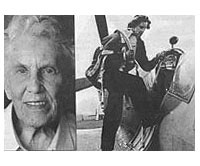|
 |
 |
 |
 |
 |
 |
 |
 |
 |
 |
 |
 |
WOBURN ABBEY
|
|
 |
 |
|
|
|
|
|
|
|
|
|
 |
Aircraft site within Woburn Abbey |
|
|
 |
Woburn opened in July, 1941, as a Satellite Landing Ground. It was the maintenance unit for Brize Norton, used for the storage of single aircraft. This was later tranferred to No. 8 maintain unit at Little Rissington.The planes that were stored included : - |
|
 |
Spitfires
Hurricanes
Battles
Masters
Tiger Moths
Magisters
An occasional Swordfish |
|
|
|
|
|
|
|
|
|
 |
|
 |
|
|
|
|
 |
|
Fairey Albacore |
|
|
|
 |
From April to December, 1944 some civilians were attached to an R,A,F. contingent and sent to Woburn to fit glider towing apparatus to Stirling bombers ready for Day-day. Before D-day 200 Stirlings were stored under trees in the Park, Approximately 25 planes were kept on alert and another 25 on one hours alert, for the delivery operations to the squadrons. The old hanger of the Flying Duchess was used as workshops and offices. |
|
 |
Lettice Curtis
Lettice Curtis (pictured right) was a lady who flew in the 1930's when airfields were springing up all over Britian. She was the first woman to fly a Lancaster bomber, despite hardly any training because she already had a pilot's license.The aircraft were ferried from the factorys to the squadons and Lettice flew Spitfires and Hurricanes, sometimes flying five planes in one day to 10 different airfields. She would get up at 9am to fly a Lancaster bomber or a Spitfire and then catch a lift back either with with another flight,or by a taxi.The R.A.F.did not have the man-power to move the planes so the ladies had to do it.You could be flying as low as 1,000ft and you would |
|
|
|
|
|
|
|
 |
 |
|
 |
have to keep your wits about you. In bad weather you just landed where you could.There were no radios and because women weren't allowed to flight, there was no ammunition. Ammunition was put into the planes when they arrived at the airfields for the male pilots. |
|
|
|
|
|
|
 |
|
 |
|
|



